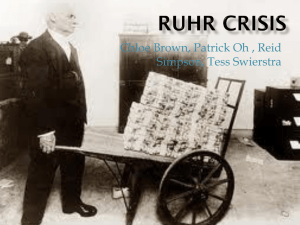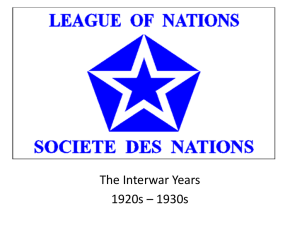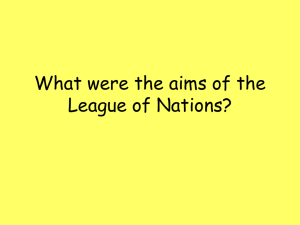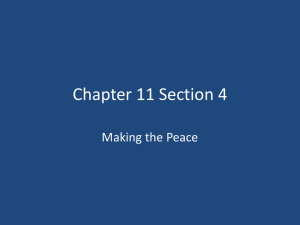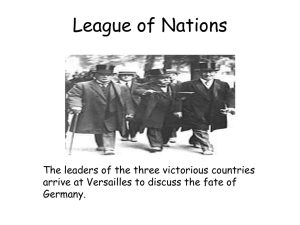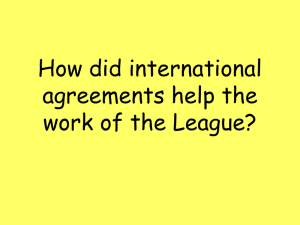CHT.LeagueofNations,1919
advertisement
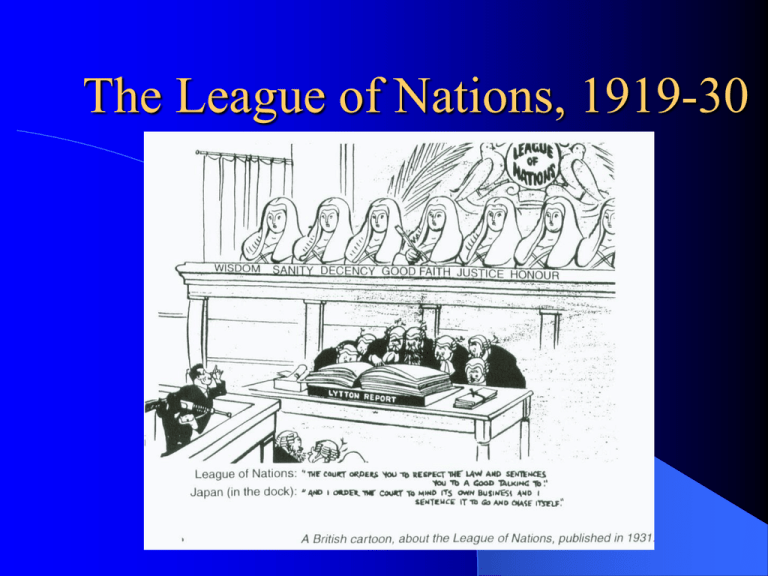
The League of Nations, 1919-30 The League of Nations A number of important principles had come out of Wilson’s 14 Points in January 1918 … • Self-Determination • General Disarmament • Peaceful discussion of international disputes • Setting up of League of Nations Wilson was determined to make sure that a war like the Great War would not happen in the future … Why was the League set up ? The League had four main aims, all of which were related to Wilson’s 14 Points of January 1918 … Bring together all nations in a parliament to discuss and settle disputes peacefully. Improve people’s working and living conditions; help people to become better off by improving international trade. It was believed that injustice and poverty were important causes of war. Make war impossible by persuading all nations to disarm, not just the losing countries from the War. Safeguard the independence of countries and their frontiers How was the League organised ? The Assembly Council Met once a year One nation, one vote Decisions had to be unanimous Met regularly to deal with incidents 4 permanent members (Britain, France, Japan, Italy) 4-11 non permanent members Secretariat Did the paperwork of the League Prepared reports Civil Service Court of International Justice Based in The Hague Settled disputes in international law 15 judges Commissions Mandates Refugees Slavery Health International Labour Organisation Membership … USA never joined – 42 countries joined at American Congress the start, rising to 60 in refused to the sign the the 1930s Peace Treaties – Wilson Defeated countries from was voted out of office WW1 could not join The League was immediately (e.g. regarded as a ‘winners Germany joined in 1926) only club’ Russia was left out – Neither Britain nor communist revolution in France gave the League their full support 1917 How would the League keep the peace ? If one country were aggressive to another, the League would force the aggressor to back down by: Pressure of world opinion World trade ban (economic sanctions) Force if necessary (though the League had no army) What the members were promising to do was to take common action to defend each other in the event of an attack. This was called COLLECTIVE SECURITY. Weaknesses of the League… Certain key nations did not join (e.g. USA) – others left (Germany, 1933; Russia joined in 1934, left 1939; Japan left 1932/3; Italy left 1936) It had no real power to enforce decisions – relied on goodwill and persuasion No permanent military force Economic sanctions did not work Failed to achieve disarmament of all nations in the 1930s (one of the 4 principal aims of the League) Decision-making was slow because both Assembly and Council required unanimous votes to take action – sometimes aggressive countries had already been successful before the League got round to action Certain key members of the Council could veto action (e.g. Italy (1935-6) and Japan (1931-2) Neither Britain nor France gave the League their full support they were more worried about their own empires and trade, particularly during the World Economic Crisis, 1929-35 We pause here so you can do some (or lots of!) work!!! Refer to our class produced .ppt of key events, treaties, etc from the 20s as well as Chapter 11 in your Wolfson and Laver text. Successes & in the 1920s Work of the League’s commissions – particularly refugees, drug trafficking, slavery etc International Labour Organisation – campaigning for improved working and pay conditions Border disputes in Upper Silesia in 1921 Aaland Islands dispute, 1921 Greek invasion of Bulgaria in 1925 failures Vilna dispute in 1920 Greek-Turkish war 1920-22 The French and Belgian invasion of the Ruhr in 1923 The Corfu incident in 1923 Failure of disarmament efforts in the 1920s – Washington Naval Treaty (1922), failure to have an international conference on disarmament until 1933 Failure of self-determination in the Treaties TOK links… Did the members of the League act with integrity and honesty in fulfilling the terms of the Covenant that they signed?


